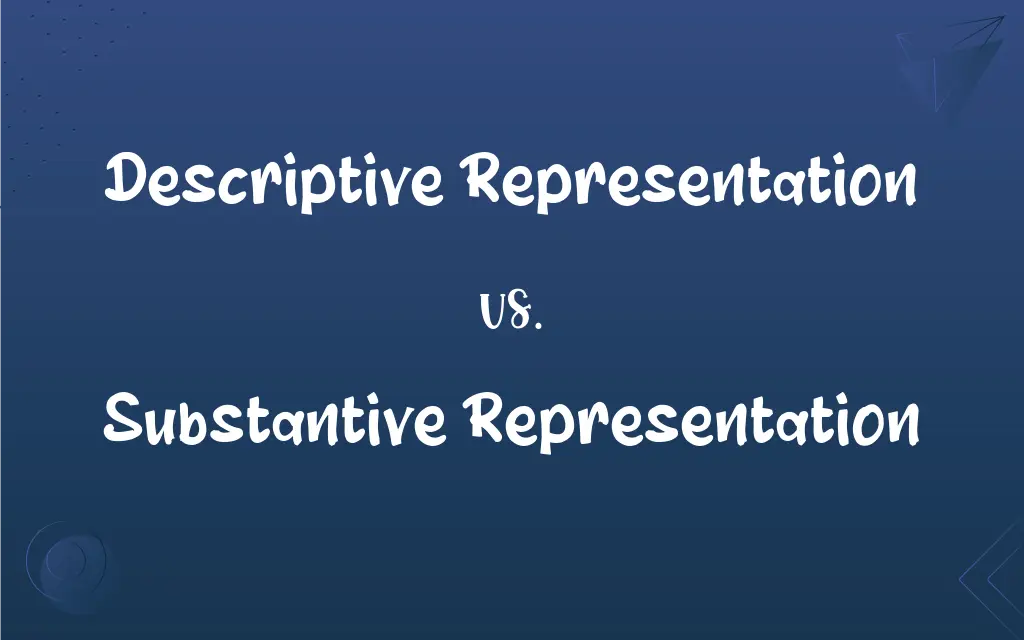Descriptive Representation vs. Substantive Representation: What's the Difference?
Edited by Aimie Carlson || By Harlon Moss || Published on January 3, 2024
Descriptive representation refers to mirroring constituents' characteristics, while substantive representation involves advocating constituents' interests and needs.

Key Differences
Descriptive representation occurs when representatives physically resemble their constituents, sharing characteristics like gender, race, or ethnicity. Substantive representation, however, focuses on the actions of the representatives in advocating and implementing policies that reflect the interests and needs of their constituents.
In descriptive representation, the emphasis is on the demographic makeup of the governing body mirroring that of the population. Substantive representation assesses how well representatives' decisions and actions align with the preferences and welfare of their constituents.
Descriptive representation symbolizes equality and inclusivity in the political process. Substantive representation, on the other hand, emphasizes effective and responsive policy-making regardless of the representative's personal characteristics.
An example of descriptive representation would be a legislature with gender balance reflective of society. Substantive representation would be evident in laws and policies that advance the interests of all genders, regardless of the gender balance in the legislature.
Descriptive representation can enhance legitimacy and trust in the political system. Substantive representation ensures that the government's actions and policies are in the best interest of the public, promoting accountability and effectiveness.
ADVERTISEMENT
Comparison Chart
Focus
Mirroring constituents' demographics
Advocating constituents' interests
Emphasis
Physical resemblance to constituents
Policy-making aligned with constituents' needs
Importance
Symbolizes equality and inclusivity
Ensures effective and responsive governance
Example
Gender-balanced legislature
Policies that benefit all genders
Impact on Governance
Enhances legitimacy and trust
Promotes accountability and policy effectiveness
ADVERTISEMENT
Descriptive Representation and Substantive Representation Definitions
Descriptive Representation
Descriptive representation can enhance the sense of belonging among underrepresented groups.
Youth representation in political bodies is an aspect of descriptive representation.
Substantive Representation
Substantive representation is not dependent on the representative's demographic characteristics.
A male representative can offer substantive representation on women's issues.
Descriptive Representation
It reflects the composition of the population in governing bodies.
A diverse congress is an example of descriptive representation.
Substantive Representation
Substantive representation means representatives advocate and implement policies reflecting their constituents' interests.
A legislator fighting for workers' rights provides substantive representation for laborers.
Descriptive Representation
Descriptive representation emphasizes the visibility of minority groups in politics.
Having LGBTQ+ members in the legislature improves descriptive representation for that community.
Substantive Representation
Substantive representation promotes accountability and responsiveness.
Advocating for healthcare reform demonstrates substantive representation for healthcare access.
Descriptive Representation
Descriptive representation means representatives share physical, racial, or social characteristics with their constituents.
Electing more women achieves better descriptive representation in gender terms.
Substantive Representation
It focuses on the actions and policy decisions of representatives.
Passing environmental laws indicates substantive representation for environmentalists.
Descriptive Representation
It is about the outward similarity between representatives and those they represent.
Ethnic diversity in city council is a form of descriptive representation.
Substantive Representation
It evaluates the effectiveness of representatives in meeting constituents' needs.
Supporting education reforms shows substantive representation for students and parents.
FAQs
What is the key focus of substantive representation?
To advocate and enact policies that align with constituents' interests and needs.
Can a government have descriptive but not substantive representation?
Yes, it's possible to have demographic representation without effective advocacy for constituent interests.
Does descriptive representation require a diversity of backgrounds?
Yes, it ideally includes a range of backgrounds such as race, gender, ethnicity, and age.
What is the main goal of descriptive representation?
To ensure the governing body demographically reflects the society it represents.
How does descriptive representation affect minority groups?
It can empower minority groups by ensuring their presence in decision-making processes.
Does descriptive representation guarantee effective governance?
Not necessarily, as effective governance also depends on the actions and policies of the representatives.
What makes substantive representation effective?
Effective policy-making that genuinely reflects and addresses the needs of the constituents.
What role does identity play in descriptive representation?
Identity is central, as it focuses on representatives sharing similar identities with their constituents.
Is substantive representation measurable?
Yes, through the evaluation of policy outcomes and how well they align with constituents' needs.
How does descriptive representation benefit society?
It promotes equality, inclusivity, and can enhance trust in the political system.
How important is the political ideology in substantive representation?
It plays a significant role, as it guides the representatives' policy priorities and decisions.
What challenges exist in achieving descriptive representation?
Challenges include overcoming systemic barriers and biases in the political selection process.
How can descriptive representation be improved?
Through inclusive policies and practices that ensure diverse candidate selection and election.
Can a representative provide substantive representation without sharing constituents' characteristics?
Yes, substantive representation is based on policy actions, not on sharing demographic characteristics.
Can descriptive representation lead to better substantive representation?
Potentially, as representatives who share constituents' experiences may better understand and advocate for their needs.
How does substantive representation impact democracy?
It enhances democracy by ensuring that elected officials are responsive and accountable to the public.
Is substantive representation always visible?
Not always; it can be complex and require in-depth analysis of policy impact.
Can there be a conflict between descriptive and substantive representation?
Yes, conflicts can arise if the demographic representation does not align with constituents' policy preferences.
Are there any limitations to substantive representation?
Limitations can arise from political constraints and the representative's capacity to influence policy.
How do citizens evaluate substantive representation?
By assessing whether the representatives' actions and policies effectively address their needs and concerns.
About Author
Written by
Harlon MossHarlon is a seasoned quality moderator and accomplished content writer for Difference Wiki. An alumnus of the prestigious University of California, he earned his degree in Computer Science. Leveraging his academic background, Harlon brings a meticulous and informed perspective to his work, ensuring content accuracy and excellence.
Edited by
Aimie CarlsonAimie Carlson, holding a master's degree in English literature, is a fervent English language enthusiast. She lends her writing talents to Difference Wiki, a prominent website that specializes in comparisons, offering readers insightful analyses that both captivate and inform.






































































